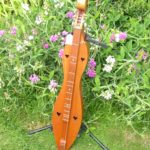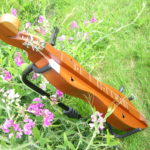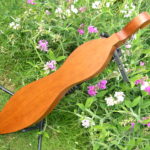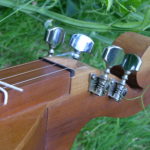3.58 Ken Hamblin 1977 4 String Hourglass £275 + £20 case
Ken, from Salem, Virginia, was born into a musical family on his mother’s side and a woodworking family on his father’s side, so it was not entirely surprising that he took up instrument making. His son sparked his interest in folk music and he discovered the dulcimer. He made a kit dulcimer and then one of his own devising in 1974. With a few under his belt, he starting taking them to craft fairs and discovered that they sold well. Many of the early ones used reclaimed timber from old houses and furniture. His reputation soon spread, but it was not until he had made his 96th dulcimer – which he still has on the wall – that Ken felt he had achieved the sound and look he wanted. The dulcimer for sale is #97! Ken retired from his day job as a machinery designer and technical illustrator in 1985 at the age of 57 and took up full-time building. He also made hammered dulcimers, autoharps, banjos and carved items such as limberjacks, doorharps and grotesques.
1977 #97: Engraved/inked on far side LB back: “Dulcimer/ No. 97/ Ken Hamblin/ Oct 1977”. Deep and quite thick all-cherry body, bookmatched on the back. Softwood top with a reddish tinge – possibly western red cedar? – which has roughly cut heart soundholes pointing to the tail. Cherry fingerboard (no overlay) without 6+ fret. MoP markers at frets 3, 7, and 10. Ebony nut and floating bridge. Mushroom-headed pins form string anchors on the top of the fingerboard-cum-tail. Thick pegbox with large, bold scroll and open-geared guitar-type tuners – which appear to be an original fitment. Has one of Hamblin’s signature “Old Joe Clark” bars or partial capos – a swivelling pin, operating on the first fret of the bass string only. Overall length 36⅝”, upper bout 5⅛”, lower bout 6¾”, depth 2¼”, FBW 1½”, VSL 27⅛”, weight 2lb 6oz (1091g). No 6½ fret. Strings currently 12, 12, 22w.
A well-proportioned, loud instrument with a good, well-balanced tone. Plays particularly sweetly in 1:5:5 tuning (DAA or similar) but still retains good intonation in DAD. Fret spacing has clearly been mathematically calculated rather than placed by ear.




